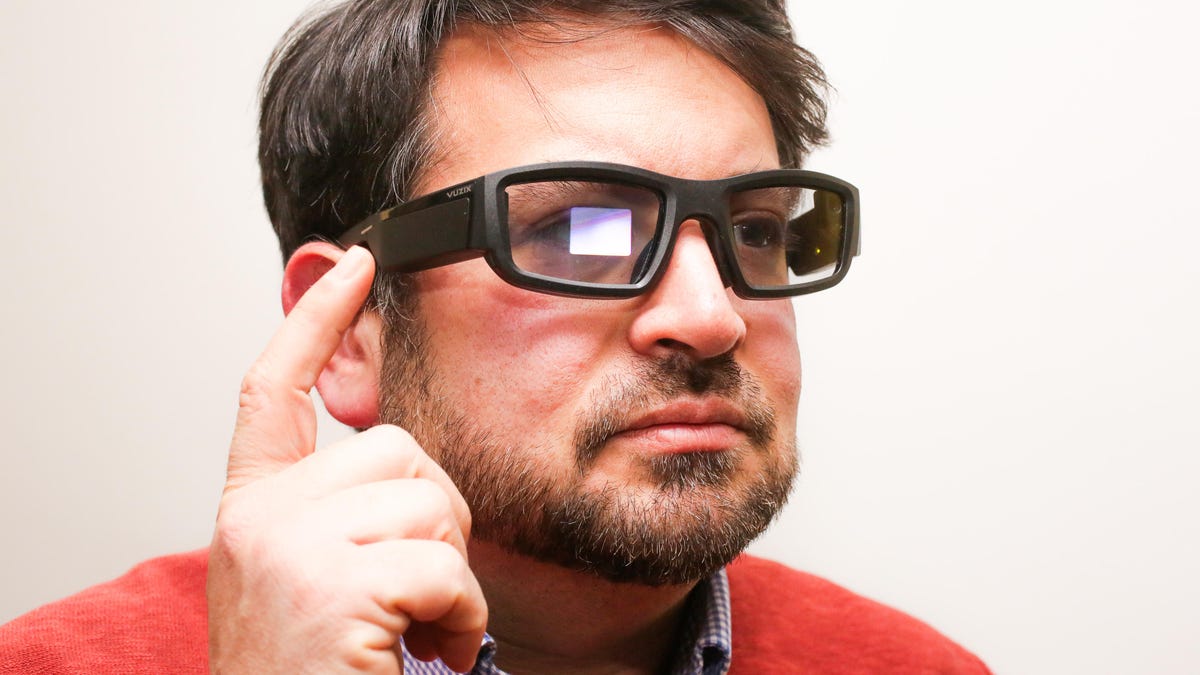Vuzix Blade test-drive: The return of the CES smart glasses
Alexa-connected smartglasses are here, minus the Alexa (at the moment). An early hands-on.

The Vuzix Blade was promised back at CES 2018: The Alexa-connected smart glasses, which I demoed then, were like an updated Google Glass that promised a larger screen and assistant modes. The Vuzix Blade is now the first product I've gotten a chance to test in 2019. So far, what I've realized is that smart glasses are really here.
Whether or not they're useful is another story.
First of all, these $999 glasses aren't really designed for you at all. Vuzix says the glasses are aimed at businesses, or those with impairments that might benefit from pop-up hands-free assistance. This has been the pitch with previous smart glasses and Google Glass-like devices, too, and Vuzix is already focused mainly on enterprise uses for these types of headgear, like the headset the company made with Toshiba that I briefly wore last year.
The Blade does, at least, look sort of like regular glasses.
I was wearing contacts when I slid on the thick black Vuzix Blade glasses, after charging them up and pairing them to my iPhone. They made me look like a cyberpunk dad, or maybe an art gallery owner.
The Blade will work with prescription lenses, too, but I haven't been outfitted with lenses yet. These lenses will let the Blade work as a pair of functioning everyday prescription glasses, at an extra price (with prescription lenses, the total cost comes to around $1200). The Blade kinda sorta works over my own glasses, but it's not designed to work well that way. I had to reposition where the display floats in my eyes, and also, I ended up looking even more ridiculous.
The glasses work as a phone accessory, like a smartwatch. I paired it to my iPhone and used Vuzix' phone app to set up the system and connect to Bluetooth and Wi-Fi. The Blade's Bluetooth connection was really buggy during early tests, dropping out a lot. Once connected, it can show notifications from my phone, use the Blade as a music playback remote, and take photos and videos. (Android phone owners can respond to messages with quick replies.) The Blade has a little red LED that lights up to show when you're taking photos of people -- a much-appreciated attempt to stop Glasshole creepshots.
The Blade floats its single-eye display into the right lens using waveguides, which allows the glasses to stay compact. The area where the image is projected has a greenish-iridescent square etched into the lens, which is otherwise normally transparent. The visuals were larger than I expected and very crisp and clear. Text floats and is easily readable in normal light, and games and apps with graphics display clearly, too, but with some ghostly semitransparency that comes with the smart glass/AR headset territory.
What can you do with these?
That's the question, isn't it? The answer for now: not all that much. The Vuzix Blade has apps, and a few preloaded games use the onboard gyroscope to work head-turning into a tank battle or dinosaur hunting. The Blade's head-turning sensitivity isn't perfectly synced, though, which started to make me nauseous.
A karaoke app with three preloaded songs encouraged me to sing along to The Girl from Ipanema, which was absurd. But besides being $1,000 karaoke smart glasses, the easy-to-read heads-up display suggests other uses for assistance and closed captioning. Epson's smart glasses have already been put to use to add captioning for the deaf for theater productions. I could see the Vuzix Blade being a useful tool for similar purposes, if someplace had the budget. It also points to a future in which assistive smart glasses could be as easy to use as wearing a device that pairs like a smartwatch.
The Vuzix Blade is an Android device, running off a quad-core ARM processor. It has a 720p/8MP video camera/still camera, and a microSD card slot for expandable storage. Technically, this is a potentially versatile little wearable computer.
It pairs with a phone, like a watch.
But the Blade needs to stay better synced, and be easier to use...and find a purpose through apps. Amazon's Alexa app, which I got to try for a few moments in an early build, shows search results and plays audio once I paired Bluetooth headphones (the Blade doesn't have in-headset speakers, or a headphone jack). Similar display-connected wearable assistant glasses could easily do the same in the future. Amazon has enabled wearables and headphones to hook into Alexa, and the Blade would be the first pair of Alexa glasses. Google Assistant support is also in the works, and both will function as apps that use the onboard noise-cancelling microphones. But the apps still aren't available for me to try on my prerelease pair, so stay tuned for deeper thoughts.
Still, the clear downside with the Blade is navigation. You need to tap and swipe the Blade's thick side arm, much like the old Google Glass. It works, but it gets tiring. These smart glasses haven't conquered easy control. Gyroscopic head-turning controls and voice commands could help, but they weren't always put to great use. And that alone, regardless of price and purpose, could be the Blade's biggest downfall. Still, the Blade doesn't even go on sale until late January, so these impressions are with early, prerelease software.
I'll update with more thoughts when final software is available.
CES 2019: See all of CNET's coverage of the year's biggest tech show.
14 questions CES 2019 has to answer: The issues dominating the tech landscape.

